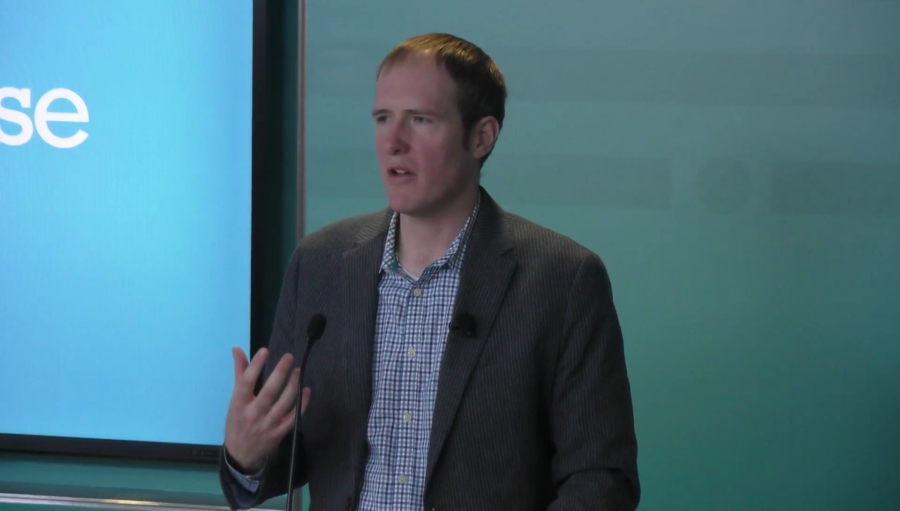Ed Finn: So, thank you all for coming. My name is Ed Finn. I am the Director of the Center for Science and the Imagination at Arizona State University. I’m also the Academic Director of Future Tense, which is a partnership between ASU, the New America Foundation, and Slate magazine that explores emerging technologies and their transformative effects on society and public policy. Central to that partnership is a series of events in Washington DC and New York City, and a blog on Slate.
In addition to the regular editorial content we have on Slate, we also have launched Futurography, a hybrid of journalism and digital learning where every month we choose a new technology or idea and break it down, asking about the state of the science, inviting experts to reflect on what’s happening, and what the major themes in the policy and research debates are. And our theme for January is “The Spawn of Frankenstein,” funnily enough. You can follow today’s conversation with the hashtag #ItsAlive, and follow Future Tense on Twitter at @FutureTenseNow.
As you saw from the documentary footage of our recent editorial meeting, our work on a new edition of the novel for scientists, engineers, and creators of all kinds is forthcoming in May from MIT Press. My coeditor Dave Guston will be here later—he’s the funny one.
Housekeeping items, please silence your cell phones. We’re livestreaming this event, so please ask the audience (That is you. I’m reading my notes.) to wait for the microphone before you ask your question. And please make your question in the form of a question, with a question mark at the end of the question. And most importantly, please stick around after the program because we will be having drinks. Yay!
So, we called this event “The Spawn of Frankenstein.” Mary Shelley’s novel has been an incredibly successful modern myth. And so this conversation today is not just about what happened 200 years ago, but the remarkable ways in which that moment and that set of ideas has continued to percolate and evolve and reform in culture, in technological research, in ethics, since then.
In February of 1817, Mary Shelley was 19 years old. She was finishing up the first draft of her book. She’d given birth to two kids, I believe, and lost one of them already. And she was an incredibly unusual person in her time. She had a very unusual upbringing. And the novel that she wrote reflects that. It brings in all of these cutting-edge, exciting, revolutionary things that were happening, such as the French Revolution. It brings in her bizarre upbringing as the somewhat benignly-neglected child of atheist philosopher radical free thinker William Godwin and the looming shadow of her mother Mary Wollstonecraft. Their home was visited by the leading intellectuals of the day, and she brought in chemistry, electricity, medical science, all of these rapidly-changing fields into her work. And in many ways it was a philosophical exercise as much as it was a novel or, as some argue, the first work of science fiction in English.
The prompt for this was a dare in the summer of 1816 on the shores of Lake Geneva to write a ghost story. And in some ways this started out as a ghost story about Mary’s own lost child, but it was also a ghost story about all sorts of missing parents and missing children. And the spectres of Victor Frankenstein and his creature today are very real. They seem to be getting more tangible every moment with every new breakthrough in synthetic biology, artificial intelligence, robotics—not even poker is safe anymore from machine learning. And the questions that haunted Shelley when she first began composing this work are getting more pressing, I would argue, as we begin in very real, very pragmatic, some ways almost quotidian ways, to create life in all sorts of different ways.
And so I’d like to open this event by arguing that this is not just a story about hubris, about man stealing fire from the gods, but also a reflection on scientific creativity and responsibility. The ways in which scientific discovery is not so different from other kinds of reproduction—from biological reproduction. The ways in which giving birth to new knowledge is like having a parental relationship. And the ways in which our creations and our responsibilities continually surprise us, especially in a world that is getting more complex and more interconnected.
After the book came out, it went viral in a very 19th century way. It was immediately ripped off for the stage, for translations. Very quickly after it came out it started to be used as a metaphor in political debates and all sorts of other cultural forms and memes. And perhaps most interestingly, Victor Frankenstein predated the word “scientist” by about twenty years. So even before we had this notion of the modern figure of the technical investigator, the scientist, we had this flawed figure, this person who balances cutting-edge modern research on the one hand, with these ancient, mystical, alchemical arts that Mary Shelley balanced in her book in the context of natural philosophy.
So the spawn of Frankenstein is legion. The myths, the figure of the mad scientist, the thoughtless creator and the creature, the monster, the demon. The abiding questions that stick with us. What it means to be alive. What it means to be human. What our responsibilities as creators are. These are the things that we’re going to be talking about today.
So we will lead in with Patric Verrone talking about the notion of playing God. Patric is a writer and producer. You may know his work from Futurama.
Further Reference
The Spawn of Frankenstein event page at New America, recap at Slate Future Tense, and Futurography’s series on Frankenstein
